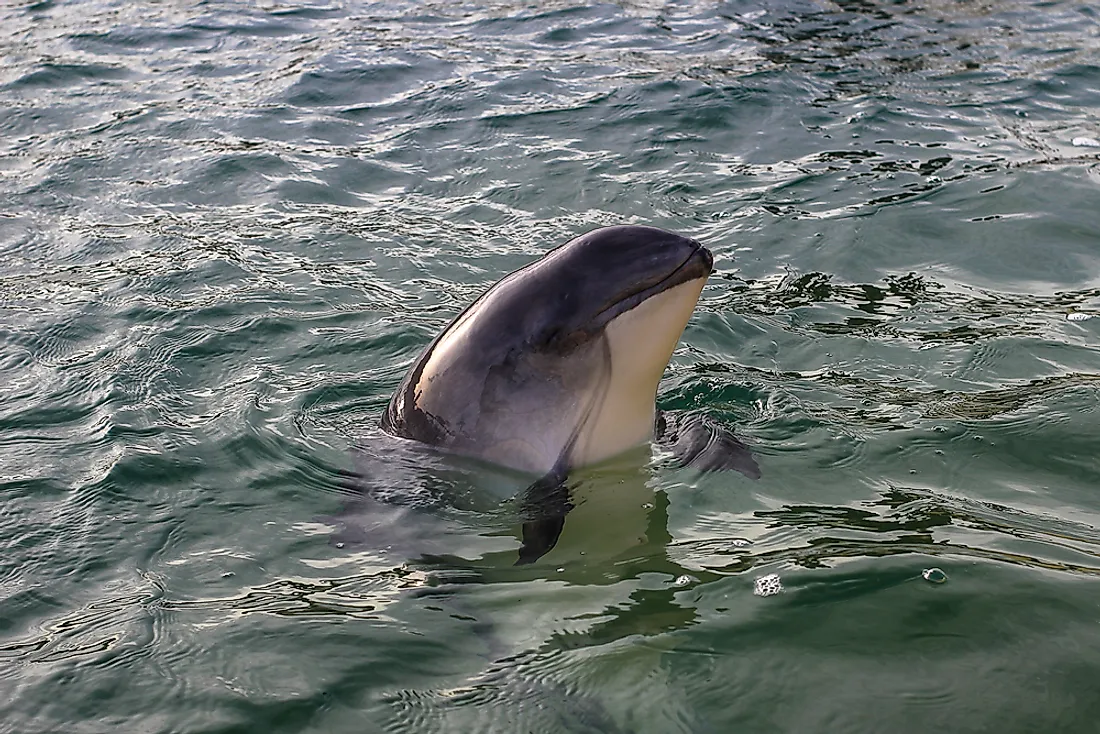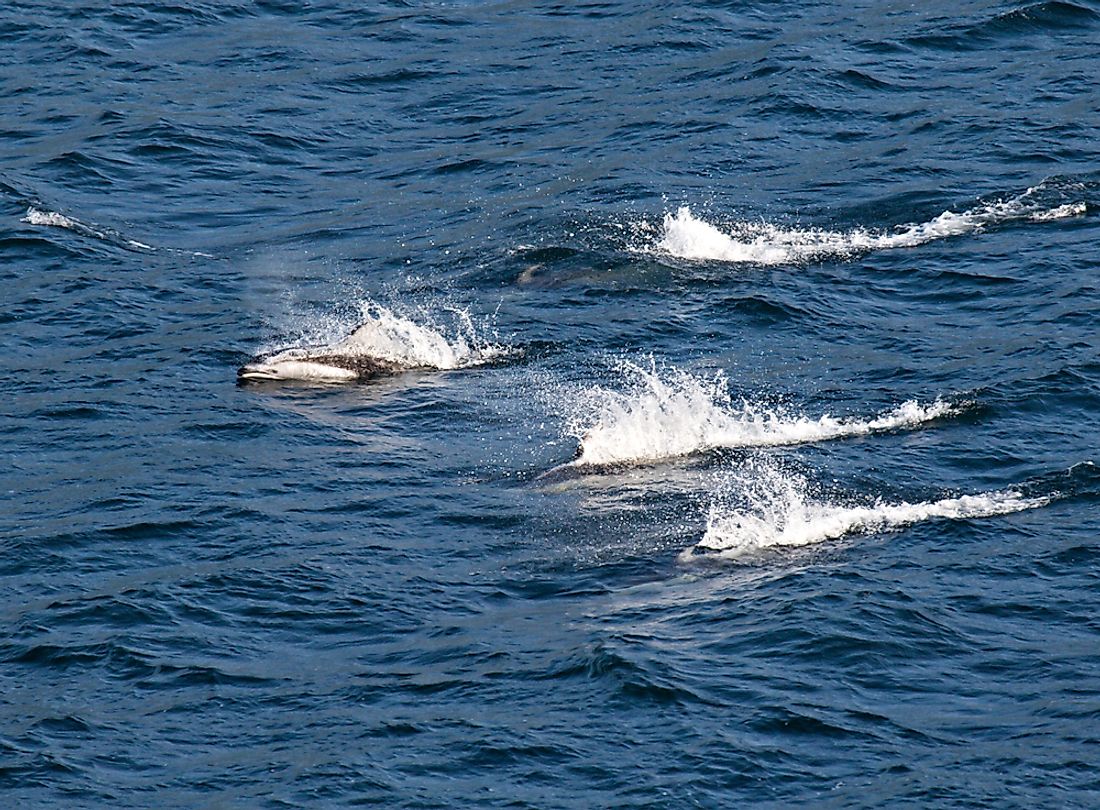The Six Species Of Porpoises Living In The World Today

Porpoises are a group of aquatic marine mammals belonging to the family Phocoenidae. Six species of porpoises inhabit the world’s oceans today including the world’s most threatened cetacean, the vaquita. Here is a list of these six species and a description of their distribution and characteristic features.
6. Finless Porpoise
The Indo-Pacific finless porpoise (Neophocaena phocaenoides) is one of six species of porpoises alive today. These porpoises live off the coast of East China, as well as in the Yellow Sea around the Korean Peninsula. A small population of this porpoise species also lives in the freshwater habitat at the Yangtze River’s mouth near Shanghai. In their range, the porpoises remain in shallow waters with a depth of up to 50 meters. They prefer mangrove swamps, estuaries, and soft or sandy beds as their habitat.
There are two subspecies of the finless porpoise. This includes the N. p. phocaenoides which range from Taiwan to the Persian Gulf, and the N. p. sunameri which range from Taiwan to the East China Sea and southern Japan. The porpoise is named so since it is the only porpoise that lacks a true dorsal fin. A thick skin-covered low ridge occupies the place of the dorsal fin. The forehead of this porpoise is steeper than that of the others. These animals grow up to about 2.27 meters in length and weigh around 72 kg. The adults of this species usually have a uniform light gray color.
The finless porpoises are opportunistic feeders that feed on fish, cephalopods, crustaceans, etc. They are also reported to ingest vegetative material such as leaves, rice, etc. when living in mangrove, river or estuary habitats. The animals usually are found in small groups of 3 to 6 but larger groups of about 50 have also been detected. The porpoises breed between late spring and early summer with a gestation period of about 10 to 11 months. Males are sexually mature at 4 to 6 years of age and females take longer, usually 6 to 9 years.
The finless porpoise is classified as "vulnerable" by the IUCN. Although there are no well-established estimates of their population, some surveys have indicated that the current population is only a fraction of the historic one.
5. Harbor Porpoise
The harbor porpoise (Phocoena phocoena) is the porpoise most encountered by whale watchers as it prefers to live near coastal areas and river estuaries. These animals also venture far away from the sea along the river course. Several subspecies of this porpoise are known to exist in distinct geographical locations. The harbor porpoise lives in the coastal waters of the Black Sea, North Pacific, and the North Atlantic. These marine mammals prefer subarctic to temperate waters.
The harbor porpoise is smaller than most other porpoise species and weighs around 53 kg. They are about 4.6 to 6.2 feet long. The animals have a poorly demarcated beak and have dark gray back, flippers, and fins. The sides are a lighter, speckled gray and their underside is white.
Harbor porpoises feed on squids, crustaceans, and small pelagic schooling fish. It usually feeds close to the sea bottom in shallow waters. The animals are generally solitary foragers but do occasionally hunt in packs. The social life of this species is not well documented and they are usually regarded as solitary. Females are sexually mature by 3 to 4 years of age and have a gestation period of about 10 to 11 months. Births are common during late spring and summer.
Although sufficient data is not present regarding the conservation status of the harbor porpoise, it is possible that these species might suffer massive population decline in the future due to climate change, overfishing, pollution, etc. The porpoises have also been traditionally hunted for food and blubber but currently are not commercially hunted. Hunting for food in Greenland continues to happen.
4. Vaquita
The vaquita (Phocoena sinus) is the rarest of the six species of porpoise and is endemic to the northern sections of the Gulf of California. It is also unfortunately regarded as the most threatened cetacean in the world and is listed as "critically endangered" by the IUCN. As of 2016, only about 30 vaquitas remained. The species will possibly be extinct soon with bycatch from the illegal gillnet fishery considered the main culprit behind the demise of this porpoise species.
Vaquitas are the smallest of all cetaceans and have a stocky built. The dark rings around their eyes, lip patches, and a line extending from the mouth to the dorsal fins are the distinguishing features of this species. The dorsal surface is dark gray while the undersides are white. Females are about 55.4 inches in size while males are slightly shorter. The animals use high-pitched sounds to communicate and echolocate. These animals are highly evasive in nature and surface to breathe, only to quickly disappear. They are less social than other porpoises and tend to live alone except when calving.
The vaquitas are non-selective feeders and feed on crustaceans, small fish, squids, octopuses, etc. They live for about 20 years if ideal conditions exist. They sexually mature between 3 and 6 years. The reproduction occurs during late spring and early summer with gestation period being 10 to 11 months.
3. Spectacled Porpoise
The spectacled porpoise (Phocoena dioptrica) as the name suggests, are distinguished by the characteristic dark ring around their eyes. The animal has a small head and no beak. The undersides of the porpoise are white and the upper surface is black in color. There is also a white stripe on the tail’s upper surface. Males grow up to 2.2 meters in length and females are a little smaller than the males.
The spectacled porpoise feeds on fish, squid, octopus, shrimp, mollusks, and other crustaceans. They live in groups of between 1 to 25. They are active swimmers and tend to avoid boats.
The spectacled porpoise is found in the low Antarctic and cool sub-Antarctic waters and have a circumpolar distribution. They live in the Atlantic, South Pacific, and the southern Indian Ocean. The porpoises tend to live near the coast and are rarely seen in the open sea. Little is known about the population and distribution of this species and is thus listed as "data deficient". However, it is possible that the species might have an unfavorable conservation status and need international co-operation to ensure its continued survival.
2. Burmeister's Porpoise
Burmeister's porpoise (Phocoena spinipinnis) is a porpoise species that is endemic to the coasts of South America. The species is named after Hermann Burmeister who first described it. The range of the Burmeister's porpoise is quite widespread, stretching from the coastal waters of the Pacific in Peru to the Atlantic coast of southern Brazil. The animals usually live close to land and are rarely sighted more than 50 km from the coast. The Burmeister's porpoises are typically dark gray in color and are about 150 cm long and weigh around 50 to 75 kg. The dorsal fin of the porpoise has an unusual shape and is triangular rather than curved. It also points backward rather than pointing upwards. The porpoises are shy and elusive creatures and usually live alone. They feed on several species of pelagic fish such as mackerel, anchovies, and hake.
The biggest threat the Burmeister's porpoise faces is accidental capture in fishing nets which is common in Chile, Peru, and Uruguay. In Peru, nearly 2,000 individuals are caught in this manner each year. The porpoises are also deliberately harpooned to be used as shark bait or for food.
1. Dall's porpoise

The Dall's porpoise (Phocoenoides dalli) is found only in the North Pacific Ocean and is named after W. H. Dall, an American naturalist. The Dall’s porpoise has a unique appearance that easily distinguishes it from other cetacean species. The animal has a stocky built with a small head. The body color ranges between dark gray to black and it has white patches on the belly and flank. These animals grow up to about 7.5 feet and weigh between 130 and 220 kg.
The Dall’s porpoise inhabits cold waters that are over 590 feet deep and prefer to stay close to deep-water canyons or in deep coastal waters in its range. The species feed on small fishes and cephalopods. They are highly active swimmers and can swim at 55 km/h, nearly as fast as the killer whale. The Dall’s porpoises live in small groups of 2 to 12 individuals, but can gather in hundreds around a food source. The males of this species guard the female to ensure that he will sire her calf. Babies are born most often during the summer after a 10 to 11 month gestation period. The life-span of the species is about 22 years. Currently, thousands of Dall’s porpoises are dying each year as by-catch in fishing nets. The use of harpoon fishing by Japanese hunters is also a serious threat to their survival.











